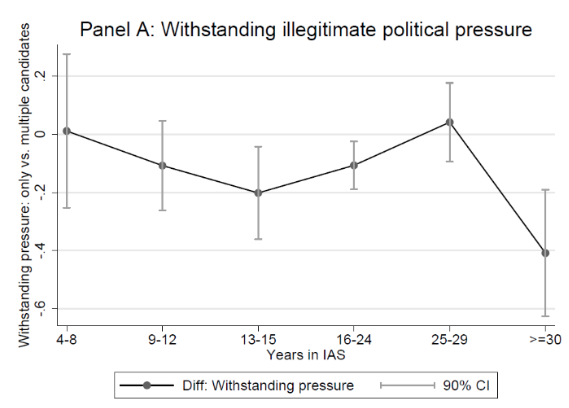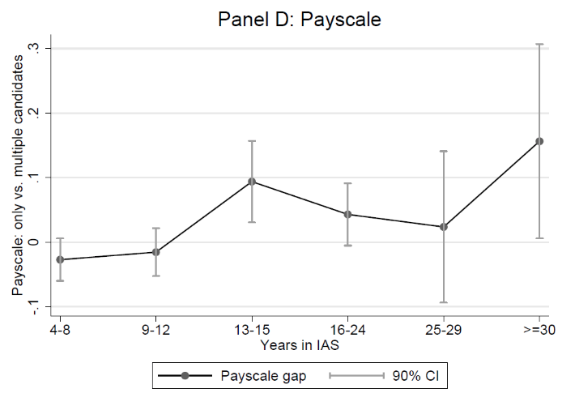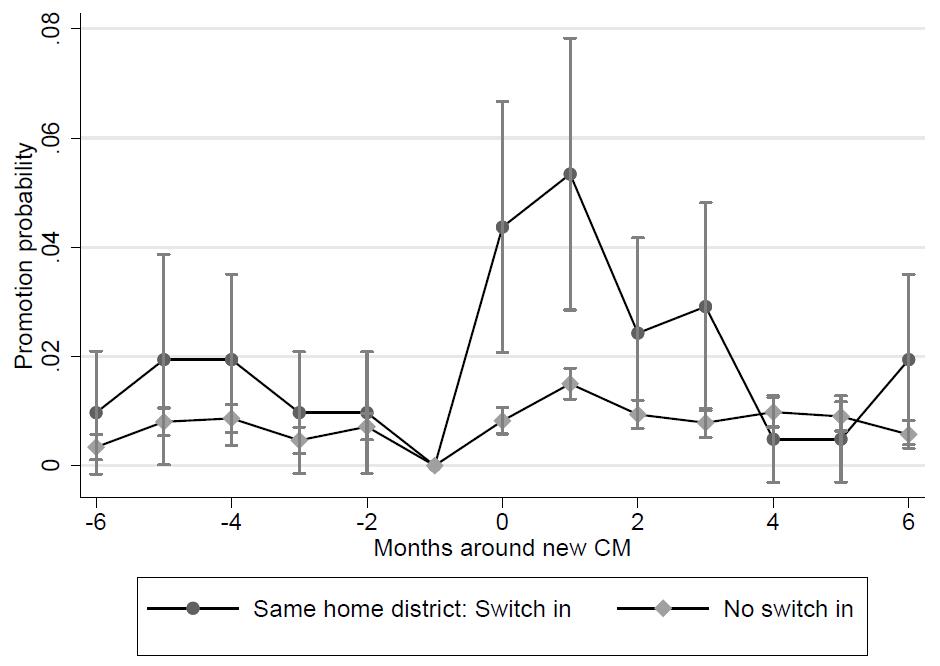Bureaucrats form an essential part of State capacity. Should they be allowed to serve in their home areas? This article finds that Indian Administrative Service officers assigned to their home states perform worse than comparable officers assigned to non-home states, are perceived to be more corrupt and less able to withstand illegitimate political pressure. This performance gap is particularly pronounced in the later career stages when there is more room for patronage and capture of bureaucracy by local political elite.
State capacity is a key determinant of development and growth (Besley and Persson 2009). Bureaucrats form an essential part of State capacity (Finan et al. 2015). They are responsible for raising taxes, providing public services, and implementing policies. How the personnel of the State performs is thus likely to have important implications for State effectiveness and economic performance (Evans and Rauch 2000).
Should bureaucrats be allowed to serve in their home areas?
A longstanding challenge in governance is to ensure that bureaucrats are indeed serving the State, and do not abuse their public office for private gain. Throughout history, there has been a shift from local rulers governing through kins, personal trustees, and court-servants to permanent professional civil services running Nation States. A central objective of such bureaucracies was to devise systems and rules that reduced the patronage and corruption that had plagued earlier systems of government (Xu 2018). Bureaucrats, however, originate from particular localities which they will have a particular knowledge of and affinity with. One question that all centralised bureaucracies face therefore concerns whether bureaucrats should be allowed to serve in the areas they originate from.
Allowing bureaucrats to work in their home areas is a double-edged sword. Sharing the same culture or speaking the same dialect might enable bureaucrats to communicate more effectively. Assigning bureaucrats to familiar environments may also allow the central government to tap into local information. Finally, bureaucrats may have greater intrinsic motivation to perform in areas they originate from.
These very same features, however, can also hinder bureaucrat performance. Greater social proximity between the bureaucrats and the localities they serve may increase collusion. Similarly, the greater informational advantage that home bureaucrats enjoy can also make it harder for the central government to monitor their actions. The same advantage could thus be exploited for private gain, or to put local interests above the national interest.
Social proximity and bureaucrat performance in India
Despite the policy importance, evidence on how social proximity affects bureaucrat performance remains relatively scant. This is the question we take up in our recent research (Xu et al. 2018) by studying the elite civil service of India – the Indian Administrative Service (IAS) – often also called the “steel frame of India”. The IAS is particularly important as the close to 4,000 centrally recruited officers from this service effectively run India, heading up all government departments at both the central and state levels. Understanding the manner in which they are allocated across the country – specifically whether or not officers are able to serve in their home states – affects their performance and could help improve state-level policies and country-wide patterns of growth and development (Asher and Novosad 2017, Bertrand et al. 2018).
To look at this issue we collaborated with the IAS training academy – the LBSNAA (Lal Bahadur Shastri National Academy of Administration) – to combine administrative records with survey data on the subjective performance of IAS officers across the major states of India. These survey-based measures, in which we elicit the perceived effectiveness, probity, ability to withstand illegitimate political pressure, pro-poor orientation, and overall performance, allow us to overcome a key challenge in the study of senior civil servants – namely, the measurement of their performance.
In order to estimate the effect of home state allocations, we leverage detailed institutional knowledge of the home state assignment rule to isolate a ‘chance variation’ that predicts whether an officer is allocated to his home state. Specifically, we exploit the fact that the number of IAS entrants who compete over a fixed number of the coveted slots earmarked for home service varies over time: the more IAS officers from the same state enter in a given year, the lower is the chance of any given officer to receive the home allocation. How many officers from the same state enter the service in a given year, however, fluctuates wildly over the years as it depends on who makes the cut in passing the competitive entry exams, thus effectively providing a lottery for home state assignments that enables us to study the performance difference among a set of officers that are comparable – but differ in whether they were assigned to their home state or not.
Our main finding is that home state allocated officers perform worse than comparable officers who are allocated to non-home states. On average looking across the entire nation, we find that officers allocated to their home states are deemed to be more corrupt and less able to withstand illegitimate political pressure. The extent to which home allocations decrease performance, however, varies substantially across states. Home state officers perform worse in states that score higher on corruption – as measured by the Transparency International score. Consistent with this subjective evidence we find that, in the more corrupt Indian states, home-allocated officers are more likely to be suspended primarily due to having court cases pending against them.
Performance difference between home- and non-home allocated bureaucrats
To study how the performance difference unfolds over the career, we show that the negative performance gap between home- and non-home state IAS officers is particularly pronounced in the later career stages. These are career stages where, we argue, there is more room for patronage and capture of the bureaucracy by the local political elite. Interestingly, it is exactly in those career stages where home-allocated officers perform worse in which we observe their greater promotion prospects (Figure 1).
Figure 1. Difference between home and non-home state officers in ability to withstand illegitimate political pressure (top, Panel A) and promotions (bottom, Panel D)
We provide corroborating evidence that home officers, especially more senior ones, are more susceptible to capture by the political elite by investigating differential patterns of political interference in the careers of IAS officers based on their proximity to Chief Ministers, the political heads of Indian states. When moving to a high frequency event study, we find that senior home-allocated officers are on average reshuffled more frequently, and more likely to be promoted in the immediate months following the appointment of a new Chief Minister. Furthermore, this surge in transfers and promotions is magnified for those home-allocated officers who originate from the same home district in the state as the incoming Chief Minister (Figure 2). The combined results are consistent with social proximity adversely impacting bureaucrat performance through political favouritism.
Figure 2. Differences in promotion probability: Home district vs. non-home district allocated officers
Policy implications
These findings thus resonate well with the historical literature which highlights the tension between the need for local knowledge and the challenge of capture and clientelism in settings ranging from the administration of an empire to the allocation of modern day civil servants and ambassadors.
Perhaps more importantly, the results also have important implications for a whole host of less developed countries that are in the process of building State capacity (Besley and Persson 2009). In these contexts, assigning officers back to environments which they are most socially proximate with may actually limit their ability to effectively serve the nation. This is an interesting result, as we know that such home avoidance rules run counter to the preferences of the officers themselves. While related research has suggested that rewarding performance with individually preferred postings may be an effective incentive mechanism (Khan et al. 2018), our results suggest that a policymaker may nonetheless seek to deliberately mismatch subordinates’ preferences and location assignments if their private gains are misaligned with public gains – in this case due to greater likelihood of local capture.
This post has been posted in collaboration with VoxDev and VoxEU.
Further Reading
- Asher, Sam and Paul Novosad (2017), “Politics and Local Economic Growth: Evidence from India”, American Economic Journal: Applied Economics, 9(1): 229-273. Available here.
- Bertrand, M, R Burgess, A Chawla and G Xu (2018), ‘The Glittering Prizes: Career Incentives and Bureaucrat Performance’, mimeo. Available here.
- Besley, Timothy and Torsten Persson (2009), “The Origins of State Capacity: Property Rights, Taxation and Politics”, American Economic Review, 99(4): 1218-44. Available here.
- Finan, F, BA Olken and R Pande (2015), ‘The Personnel Economics of the State’, NBER (National Bureau of Economic Research) Working Paper 21825.
- Iyer, Lakshmi and Anandi Mani (2012), “Travelling Agents: Political Change and Bureaucratic Turnover in India”, Review of Economics and Statistics, 94: 723-739.
- Rauch, James E and Peter B Evans (2000), “Bureaucratic Structure and Bureaucratic Performance in Less Developed Countries”, Journal of Public Economics, 75(1): 49-71. Available here.
- Xu, Guo (2018), “The Costs of Patronage: Evidence from the British Empire”, American Economic Review, 108(11): 3170-98.
- Xu, G, M Bertrand and R Burgess (2018), ‘Social Proximity and Bureaucrat Performance: Evidence from India’, NBER Working Paper No. 25389, December 2018.




 08 April, 2019
08 April, 2019 









Comments will be held for moderation. Your contact information will not be made public.